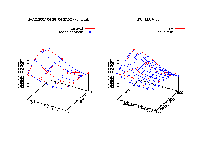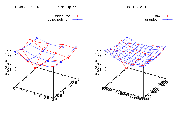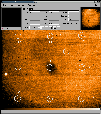|
|
 |
| |
| QC PLOTS |
| |
CURRENT |
HISTORY |
| effective illumination |
 |
 |
| QC1 database (advanced users):
browse
|
plot
|
Click on CURRENT to see the current trending (Health Check).
Click on HISTORY to see the historical evolution of the trending. |
From the beginning of operations, the ISAAC calibration plan includes the regular acquisition of illumination correction calibrations. A photometric standard star is observed 16 times on a regular grid over the field of view. Calibrations are taken once or twice a year in SW: H, J, Js, Ks and LW: H, J+Block and K. In 2007 illumination correction frames have been investigated and all OBs have been reprocessed. The pipeline generates one FITs table file containing the extracted fluxes of the photometric standard star and a FITs imaging product with a polynomial. Illumination correction calibrations can be used to retrieve more accurate photometry from imaging science frames. It is recommended to use the same flatfield for the science recipe and the illumination recipe in order to eliminate the gradients intrinsic to the twilight flat.
Within the ESO VLT dataflow and QC process illumination correction frames are used only as technical calibrations to monitor the throughput of the instrument across the FOV. Hence no twilight flat correction is applied.
As an example all SW-arm K-band illumination correction products are shown:
 |
 |
 |
 |
 |
 |
| 1999-04-03 |
1999-06-02 |
2001-02-30 |
2001-08-14 |
2001-09-12 |
2001-11-09 |
 |
 |
 |
 |
 |
 |
| 2002-03-29 |
2002-07-22 |
2003-04-07 |
2003-04-08 |
2004-02-09 |
2004-10-27 |
 |
 |
 |
 |
 |
 |
| 2005-04-11 |
2005-12-12 |
2006-04-24 |
2006-12-12 |
2007-04-24 |
2007-09-12 |
 |
 |
 |
|
|
|
| 2007-11-05 |
2008-05-09 |
2008-09-16 |
|
|
|
For each OB/AB a QC report is generated showing on the left panel measured fluxes and the grid points
of the polynomial fit. On the right panel a comparison fit is shown.

For the LW-arm, an example QC report is given here:

In the LW-arm there appears a local depression matching star position #8 on the chip.
The second order polynomial does not resolve the local feature, but lowers the quality of the fit

|
top
illumination parameters |
QC1 parameters
| parameter |
QC1 database: table, name |
procedure |
| source acquisition parameters |
isaac_illu, qc_x1, qc_y1, qc_f1 |
- The position [pixel] and the counts [ADU] of the source on the first frame
- scales with square root of signal |
| polynomial coefficients |
isaac_illu, qc_illum1, qc_illumx, qc_illumy, qc_illumxx, qc_illumxy, qc_illumyy |
- polynomial coefficients that fit the 17 flux values over the field of view. |
| effective illumination |
isaac_illu, qc_eff_ul, qc_eff_ur, qc_eff_ll, qc_eff_lr, qc_eff_cc |
- polynomial coefficients applied to five selected points in the FOV: the four centers a quadrants and the center of the detector, the effective illumination |
| mean effective illumination |
isaac_illu, qc_corr_mean |
- the mean of the five qc_eff values |
| rms of mean effective illumination |
isaac_illu, qc_corr_stdev |
- the standard deviation of the five qc_eff values |
| mean flux |
isaac_illu, qc_flux_mean |
- the mean of 17 flux values, used to normalize the polynomial |
| rms of mean flux |
isaac_illu, qc_flux_stdev |
- the standard deviation of the sample of 17 flux values |
Trending
In addition to the flux values, the star identification including RA, DEC are stored in the QC1 database.
|
![[ ESO ]](/images/eso-logo.gif)
![[ ESO ]](/images/eso-logo.gif)
